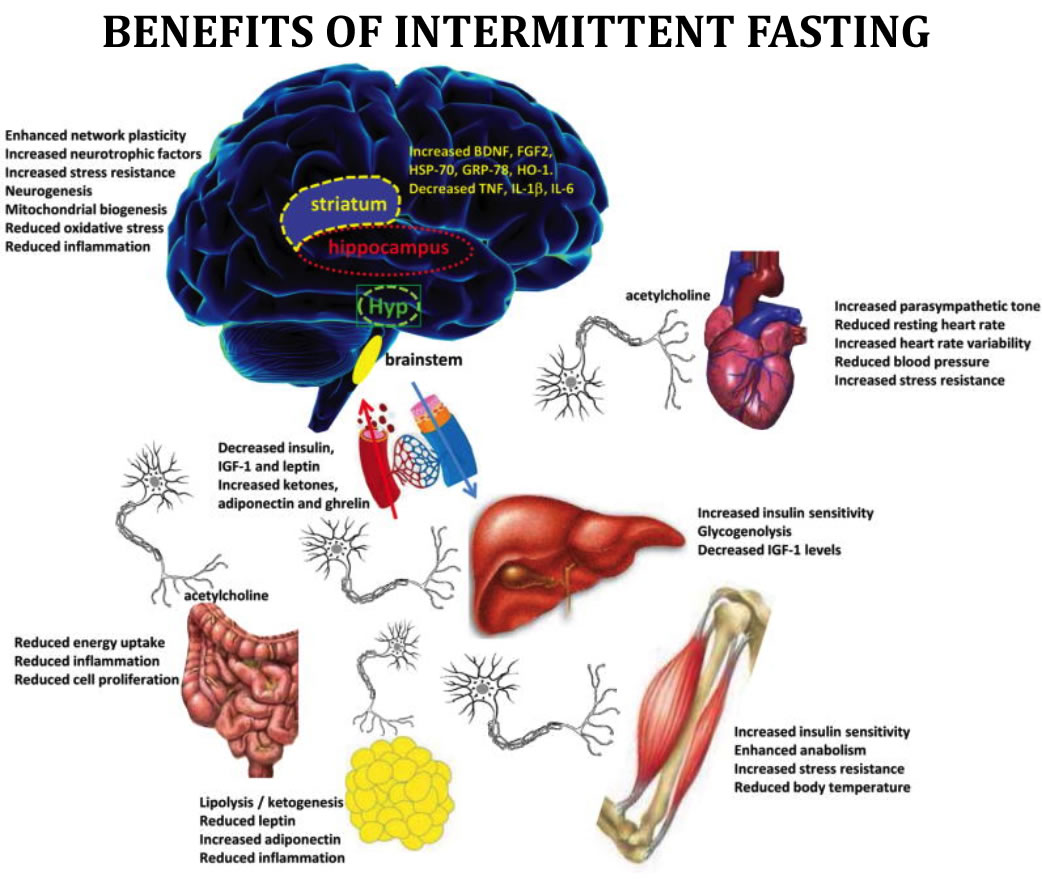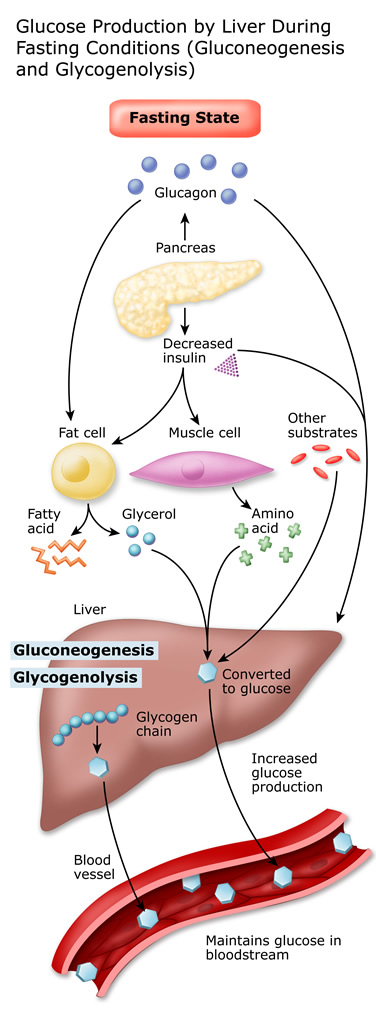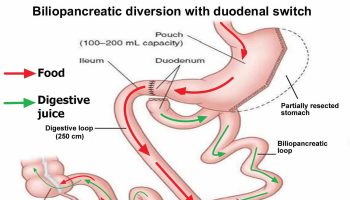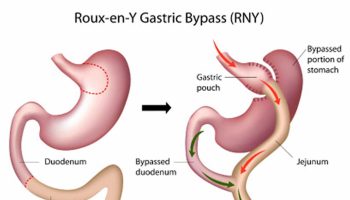Contents
What is Intermittent Fasting ?
The most accurate definition is the simplest one: intermittent fasting is merely alternating intervals of not eating (fasting) with times when you are allowed to eat.
Some plans encourage you to skip food entirely for up to 24 or 36 hours at a time. On others, such as the Every Other Day Diet and the 5:2 Fast Diet, you can have some food but only get about one fourth of your regular calories.
What ? No eating ? But what about starvation mode ? What about feeding my metabolism ? What about going into a severe catabolism so great that I have no energy and I can’t build muscle ?
It is well known that in humans, even a single fasting interval (e.g., overnight) can reduce basal concentrations of metabolic bio-markers associated with chronic disease such as insulin and glucose.
By now, we hope we’ve convinced you—with science and real life results—that those are just myths. That line of thinking is why so many people struggle to look and feel better. This is about remembering that you need to step outside of the Ordinary World in order to create an unreal life.
But when you take a closer look at the reality of intermittent fasting, you quickly realize that the concept isn’t crazy or uncommon. In fact, everyone practices a variation of intermittent fasting each day. When you sleep, you fast. When you awake, you eat. That’s intermittent fasting. Not so bad, right ?
And it also happens during your typical workday. When you’re stuck in meetings all day and don’t have a meal for five hours, that’s technically fasting. The only difference is that you aren’t on a structured timetable of meals in which the window of fasting is constant, so rather than fasting intermittently, you’re fasting haphazardly—and there’s no benefit.
Some research shows that intermittent fasting works. In one study, overweight adults who cut calories by 20% every other day dropped 8% of their body weight within 8 weeks. They also had less inflammation, significant decreases in fasting insulin and significant improvements in lipids. And there were mean improvements in mood including reductions in tension, anger and fatigue and increases in self-confidence and positive mood.
To our knowledge, there are a few studies that have explored the metabolic effects of intermittent fasting. Although limited, these data suggest that intermittent fasting regimens can result in modest weight loss. These data also show some positive impacts on metabolic parameters, even though these studies enrolled normal-weight adults who were unlikely to show substantial improvements in metabolic risk factors.
Benefits of Intermittent Fasting
Researchers aren’t sure why, but it seems that regularly fasting — severely restricting food and drink for one to two days a week — can potentially improve your heart health. This may be because people who routinely fast show self-control over how many calories they eat and drink, and this behavior may translate into weight control and better eating choices when they aren’t fasting.
Periodic fasting and better heart health may also be linked to the way your body metabolizes cholesterol and sugar. Regular fasting can decrease your low-density lipoprotein, or “bad” cholesterol. It’s also thought that fasting may improve the way your body metabolizes sugar. This can reduce your risk of gaining weight and developing diabetes, which are both risk factors for heart disease.
The possible secret behind the diet’s health-boosting benefits: Fasting puts your cells under a mild stress. Scientists think that the process of responding to this stress, on your low-calorie days, strengthens cells’ ability to deal with stress and potentially fight off some diseases.
If you look at all the research, compare the high-fat diets to low-fat, the high-carb programs to low-carb, and the protein to more-protein (because every diet needs protein), you discover something that would surprise most people. Many diets work. There is no magic bullet. There is no “killer” food that ruins your eating plan. That’s just not how our bodies work. But what causes diets to fail are psychological and social limitations that people don’t deal with—no booze, no late-night eating, or no burgers. You need something with rules that work but also flexibility that allows you to have a life you can enjoy—and a body you can enjoy looking at.
On the most basic level, only two things matter: the calories you eat and taking in some balance of macronutrients—proteins, carbs, and fats. The manipulation of those macronutrients and calories on a daily, weekly, or monthly basis is the special sauce that allows for progress.
So if all foods are fair game and eating some bad foods is actually okay, then why do so many people struggle with their diet ?
It’s because the system of eating is broken. It’s based on mistruths, mistakes, and dogma. People are taught that eating can only be done one way, and their indoctrination creates a system in which their body always wants and expects food. They burn less fat because they spend too much time eating. And they struggle with binges because they’re told to resist the foods they love—which of course only results in them eating more of those foods than they would otherwise.
This is why intermittent fasting is so successful. It eliminates all the problems that cause you to fail. We’ll walk you through the different forms of intermittent fasting soon, but before we do, it’s important that you understand why it works and why it’s not only the most flexible plan you could find—but also much healthier than most believe.
All we’re going to do is teach you how to ever so slightly expand your fasting window so you can experience the benefits of burning more fat, building more muscle, improving aging, boosting your sex drive, fighting off disease, looking more attractive, and strengthening your overall health. And when you fast intermittently, you have rules, but you are in control.
It’s a simplified approach. And while it’s detailed and calculated, everything revolves around one easy-to-follow principle: eat by your clock. You set the hours that you eat. And then you have enhanced food freedom unlike any program you’ve ever tried before.
These are the only rules of Intermittent Fasting:
- Fast: Go without eating for a period of time. Most days, this will just be sixteen hours.
- Eat: Select an eight-hour window—any eight-hour window—and use that as your eating time. You could start eating at 9:30 A.M. and then have your dinner at 5:30 P.M. For us, that means we start eating at two P.M. and end at ten P.M.
- Be flexible: If you want to eat at ten A.M. one day or have a business breakfast planned, go for it. Ideally you’d just eat from ten A.M. to six P.M. Or if you don’t want to start eating until four P.M., do that.
The best part about intermittent fasting is that it’s designed to work for you. The restrictions are only related to overcoming your mental blocks and learning to control your hunger, which will become invaluable skills once you learn that your symptoms of hunger are more because of the eating schedule you’ve created than actually needing food.
When combined with exercise, it creates an optimal hormonal environment that will produce even greater results. And even if you choose not to exercise (although it’s not what we’d recommend), intermittent fasting has been proven to be an effective weight-loss technique and a strategy that can mimic many of the health benefits of exercise, including fighting disease and improving longevity. For those who are active—as we recommend—intermittent fasting will enhance everything you do in the gym.
We know that letting go of your previously held beliefs can be difficult. And we acknowledge that for some people, it can take seven to ten days to adjust to an intermittent fasting schedule. But once you find a pattern that works for your lifestyle, you’ll see that you’ll never have to search for another diet again.
There are several variations of intermittent fasting, and we’re going to show you how to integrate each one during the four phases of the program for the best results. The fasting period you’ll use can range anywhere from sixteen hours all the way up to thirty-six hours (with several stops in between), and each of those plans has specific benefits. In the diet part of the program, we’ll show you exactly when you need to apply each form of fasting and make it simple for you to make this new form of eating feel effortless.
- Most people on an intermittent fasting plan forego eating during traditional breakfast time; instead of eating first thing in the morning, they have their first meal in the afternoon. (You can still follow an intermittent fasting schedule and eat early in the morning.) This advice is exactly the opposite guidance bestowed by every authority from registered dietitians to doctors. Insulin sensitivity is higher when your glycogen levels (the energy stores in your body) are depleted, like after your sleeping fast.Intermittent fasting takes that a step farther and turns your body into a fat-burning, muscle-building machine. You see, if you skip breakfast and extend the fasting period beyond the typical eight to ten hours, you increase insulin even more. Insulin sensitivity is also increased after you exercise (due to further glycogen depletion), in which case if you can train in your fasted state in the morning and then eat, you have set your body up to maximize fat burning in the morning. What’s more, you turn all your post-workout meals—so everything you eat the rest of the day—into super fuel that will have you looking leaner (and more muscular) and feeling more satisfied and energized than ever before.
In the end, there is no science that supports the idea—from a direct comparison—that eating breakfast is better than not eating breakfast. Some people might have a psychological dependence or belief that it’s what they need, or they could have a habit of binging when they are hungry. But from a physiological perspective, as in how your body actually reacts to breakfast, there’s nothing special about eating early in the morning. In fact, forcing yourself to eat at a particular time, or a prescribed number of times, is just as big of a problem as saying you need breakfast.
- You choose when and how often you eat. The reality is that your body doesn’t care about how many meals you eat. You can choose how often you want to eat every day. The thermic effect of food is directly proportional to caloric intake, and if caloric intake is the same at the end of the day, there will be no metabolic difference between eating six meals or three.We know that the amount of energy you burn depends on the food you eat. This is known as the thermic effect of food. Of all the foods you eat, protein is the most metabolically expensive—it costs more energy to break down, digest, and put to use than either carbohydrates or fat. Up to 30 percent of the calories you eat from protein are burned during the digestion and processing of those foods.That’s one of the main reasons why diets with protein are so great; the more protein you eat, the more calories you burn. Carbohydrates are less metabolically active (about 6 to 8 percent burned), and fats are the least metabolically active (about 4 percent burned) despite being the highest in calories. The best approach to your diet is the one that is sustainable for you and fits your lifestyle. With regard to energy balance and thermic effect of food, you can really eat as many meals—or as few—as you want. Your body primarily functions based on how much you eat, the composition of what you eat, and the sources of food you select. There are reasons why eating less frequently could be a better choice for you and your body. Researchers at the University of Kansas Medical Center found that eating more frequently is less beneficial from the perspective of satiety, or feeling full. Which means that the more often you eat, the more likely you are to be hungry—leading to higher caloric intake and eventual weight gain. In other words, whether you realize it or not, when you eat more often, you’re more likely to eat more food. When you eat less frequently, you can eat larger meals and feel more satisfied, and you’re less likely to take in more calories.This also makes sense if you’re following an intermittent fasting routine to limit the number of hours you eat during the day. If you condense the amount of time you allow yourself to eat into a small window of four to eight hours, having more than two to three meals becomes impractical at best and impossible at worst. That’s why most of people prefer to have just two to three meals, and they find that this works perfectly with their schedule and lifestyle. If more meals are needed, that’s fine too—as long as it works within the intermittent fasting schedule and the eating window (eight to ten hours, on most days) that you create.
There really aren’t any downsides and it’s the only eating strategy to help optimize hormones, according to what we’ve found within scientific literature. For starters, there’s the improved insulin sensitivity that comes with fasting, especially when paired with the exercises. Fasting also increases the secretion of growth hormone, offsets cortisol production, helps control leptin and ghrelin levels to keep you satisfied.
Intermittent fasting isn’t for everyone. Some people might try it and not like the approach. But for health benefits and ease of application, you won’t find many dieting strategies with fewer rules. As you’ll discover, after the initial phase, you’re able to eat carbs, fats, proteins, and even dessert. You can eat breakfast—or skip it. You can drink alcohol—with the right approach—and you are even required to eat dessert on cheat days. All of the other dietary facts that are supported by science remain consistent with intermittent fasting. All that changes is that you choose an eating “window” that works best for your schedule, and simply shrink the number of hours that you eat. It’s an adjustment, but one with many benefits and something you should try before you assume it’s not going to work for you.
We realize that you might have some reservations. For most people, the main reservation is the fear of going into starvation mode or the idea that not eating for long periods of time is unhealthy. But we can assure you that you won’t starve by going twelve hours, sixteen hours, or even thirty-six hours without food. The biggest blocks during the fasts will be mental.
In the end, people will look good, feel great, and live healthier lives. And that’s what intermittent fasting offers. For people looking to drop weight, intermittent fasting can help people reduce food intake by 30 percent without increasing hunger. And because you’re eating smaller amounts and less frequently, your body can look elsewhere in your body for energy, which encourages cellular repair. Keep in mind you’re only fasting for brief periods; when you eat again your body will be rejuvenated. All told, this phenomenon—which, again, stems from caloric restriction—can generally help prevent both disease and age.
We’ve already provided plenty of evidence of these health benefits. But to further deliver the point, researchers at the University of Utah found that people who fasted just one day per month were 40 percent less likely to suffer from clogged arteries. In the survey-based study, more than five hundred people had their regular habits assessed. These habits covered eating schedules, including fasting; choice to smoke or not; and consumption of or abstinence from caffeine or alcohol. And only one trait—fasting—was correlated with lower rates of heart disease. Even when adjusted for age, weight, cholesterol, diabetes, or high blood pressure, the difference between fasters and non-fasters still remained.
Are there any benefits to intermittent fasting diets or fasting in general ?
Some people fast as a way to lose weight. Others fast to try to detox their bodies or for religious reasons. Most fasting diets achieve weight loss through the same equation—a reduction in total daily calories consumed in relation to the calories needed to maintain your weight.
Although fasting implies an intentional abstention from food, the physiologic adaptive mechanisms (not necessarily psychologic) that come into play during this type of food deprivation are similar to starvation. These terms will be used synonymously, therefore, except when important differences are known to exist.
An appreciation of the physiology of fasting is essential to the understanding of therapeutic dietary manipulations and the effect of food deprivation in various diseases. Critical evaluation of protein-sparing diets, ketogenic diets or other hypocaloric mixed-diet regimens requires a knowledge of the response to acaloric fasting.
Intermittent Fasting Science – The Metabolic Adaptation of Fasting
The transition from the fed state through brief fasting and into prolonged starvation is mediated by a series of complex metabolic, hormonal
and glucoregulatory mechanisms. The interrelationship between body fuel stores and the time sequence for their mobilization via glycogenolysis, gluconeogenesis, lipolysis and ketogenesis is diagramed in Figure 3 (see below). The fasting caloric homeostasis diagram conveniently divided the transition from a fed to a fasted state into three stages:
Stage 1: the Postabsorptive Phase
- 6 to 24 hours after beginning fasting, during which cerebral glucose requirements are maintained primarily via glycogenolysis.
Stage 2: the Gluconeogenic Phase
- From two to ten days of fasting, during which glucose requirements are met using gluconeogenic amino acids, lactate, pyruvate and glycerol, and
Stage 3: the Protein Conservation Phase
- The phase beyond ten days of fasting, characterized by decreasing protein catabolism as fat stores are mobilized and tissue use of free fatty acids and ketones increases. In prolonged starvation survival depends on conserving protein stores while energy for essential metabolic functions is maintained. Cerebral adaptation to ketone use lowers glucose requirements, thereby reducing the need for gluconeogenesis. The fall in urea excretion suggests decreased hepatic gluconeogenesis from amino acids. In addition, the hyperketonemia of starvation may exert a direct inhibitory effect on gluconeogenesis.
Hepatic glycogenolysis provides about 75 percent of the glucose requirements early in fasting glycogen reserve of 70 grams. The remainder comes from gluconeogenic precursors: amino acids (10 percent to 15 percent), lactate and pyruvate (10 percent to 15 percent) and glycerol (1 percent to 2 percent).
Muscle glycogen is metabolized to lactate that is released into the circulation and is resynthesized into glucose by the liver and kidney. Although this process (the Cori cycle) results in no net production of glucose, an advantage exists in that glucose synthesis from protein catabolism is reduced and the energy for resynthesis is derived from the oxidation of fatty acids, a plentiful and readily available energy source.
Glycerol, a by-product of the hydrolysis of triglycerides and release of free fatty acids, provides a small but significant non-protein derived gluconeogenic precursor in prolonged fasting. Thus, although humans cannot synthesize glucose directly from fat, the energy derived from oxidation of free fatty acids facilitate glucose synthesis from lactate and glycerol.
As mentioned earlier, gluconeogenesis from protein derived amino acids provides 10 percent to 15 percent of the substrate in the early fasting period. Although all amino acids except leucine are potentially gluconeogenic, a specific pattern of precursor availability occurs. Alanine, which constitutes no more than 7 percent to 10 percent of all amino acid residues in skeletal muscle, accounts for 30 percent to 40 percent of amino acids released from muscle after an overnight fast.
It is now well established that this increased output represents de novo alanine synthesis in muscle by transamination of pyruvate.
The concentrations of branched chain amino acids (valine, leucine, isoleucine) are increased early in fasting, reaching a peak at approximately the fifth day. These amino acid and serum alanine levels rose early during the fasting period. The branched chain amino acids
appear to be preferentially catabolized in muscle and provide the nitrogen source for the transamination of pyruvate to alanine. Subsequently,
the alanine released by muscle is taken up by the liver and kidney where it is resynthesized into glucose.
The amino groups are converted to urea, which is excreted in the urine. This glucose-alanine cycle, which is comparable to the Cori cycle discussed earlier, represents a major glucohomeostatic mechanism in the early fasting period. This cycle provides a source of alanine that the liver uses, more efficiently than it uses any other amino acid to make glucose.
The hyperketonemia of starvation exerts a direct protein-sparing effect by reducing alanine release from muscle. Although the exact mechanism is not known, it has been suggested that ketones may directly inhibit the oxidation of branched chain amino acids in muscle, thereby stopping the synthesis of alanine and turning off the glucose-alanine cycle.
Conversely, recent evidence indicates that alanine may inhibit ketone production directly, suggesting the presence of a ketone-alanine cycle.
Lipolysis and Ketogenesis
In the transition from a fed to a fasted state, fat stores are rapidly mobilized. Lipolysis, which is the hydrolysis of triglycerides to free fatty
acids and glycerol, is stimulated by a fall in insulin levels and a rise in glucagon levels.
In the post-absorptive state free fatty acids are mobilized at the rate of about 7 grams per hour and are taken up by the liver at about 3 grams
per hour where they are terminally oxidized to CO2, partially oxidized to ketone bodies (ketogenesis) or resynthesized into triglycerides (lipogenesis). As fasting continues, increased cerebral use of ketone bodies occurs as greater ketonemia develops. Serum levels of ketone bodies rise steadily during three to four weeks, whereas lipolysis and ketogenesis are maximal by three days.

In fasting states blood glucose levels fell early during fasting and remained low throughout the fasting period. Insulin levels became appropriately reduced as glucagon increased significantly. Liver glycogen is depleted in the first 18 to 24 hours.
Protein, which has essential enzymatic, structural and mechanical functions, constitutes 15 percent of total body energy stores. Because of these essential functions, the breakdown of a third to a half of the body protein stores is believed incompatible with life. Muscle, another site of glycogen stores, lacks glucose-6-phosphatase and therefore cannot release glucose directly into the bloodstream.
Fat in the form of triglycerides in adipose tissue provides the largest and most efficient storage of body energy and constitutes 85 percent of
all potentially available calories. In a 70-kg person basal caloric requirements could be met solely from fat stores for two to three months in
the absence of any caloric intake.
Summary on the Metabolic Effect of Fasting
As fasting continues, progressive ketosis develops due to mobilization and oxidation of fatty acids. At higher blood levels of ketones, the brain
is able to use ketones as a primary energy source, thereby decreasing the need for gluconeogenesis. The specific feedback is probably by ketones on release of alanine from muscle. The ketotic phase of fasting is then associated with protein sparing. Lean persons become ketotic earlier than obese persons, and women become ketotic more rapidly than men.
Several hormonal changes occur during fasting, including a fall in insulin and T3 levels and a rise in glucagon and reverse T3 levels, which
contributes to protein sparing.
Fasting may yield psychological benefits as well. The subjective psychologic effects of fasting may produce a sense of well-being or euphoria. Neurologically, there is evidence that ketosis may increase seizure thresholds in patients with epilepsy.

Fasting and weight loss
Since 1915 repeated short periods of starvation or fasting as a safe therapy for obesity has long been advocated and has been shown to be effective safe method of weight reduction. Fasting for a few days probably won’t hurt most people who are healthy, provided they don’t get dehydrated.
Fasting has been shown to produce rapid weight loss early, averaging 0.9 kg per day during the first week and slowing to 0.3 kg per day by the third week; early rapid weight loss is primarily due to negative sodium balance. The concern with fast weight loss is that it usually takes extraordinary efforts in diet and mental discipline that could be unhealthy and that you probably can’t maintain as permanent lifestyle changes.
Also, if you lose a lot of weight very quickly, you may not lose as much fat as you would with a more modest rate of weight loss. Instead, you might lose water weight or even lean tissue, since it’s hard to burn that many fat calories in a short period. However, faster weight loss can be safe if it’s done the right way. For example, doctors might prescribe very low calorie diets for rapid weight loss if obesity is causing you serious health problems. But an extreme diet like this requires medical supervision. And it can be difficult to keep this weight off long term.
A weight loss of 1 to 2 pounds a week, which is not only safe but also realistic and sustainable for the long term, is the typical recommendation. Although that may seem like a slow pace for weight loss, it’s more likely to help you maintain your weight loss for the long term. Remember that 1 pound (0.45 kilogram) of fat contains 3,500 calories. So to lose 1 pound a week, you need to burn 500 more calories than you eat each day (500 calories x 7 days = 3,500 calories).
Metabolically, early fasting is characterized by a high rate of gluconeogenesis with amino acids as the primary substrates. As fasting continues, progressive ketosis develops due to the mobilization and oxidation of fatty acids. As ketone levels rise they replace glucose as the primary energy source in the central nervous system, thereby decreasing the need for gluconeogenesis and sparing protein catabolism.
A word of caution, rare medical complications of short-term fasting include gout, urate nephrolithiasis, postural hypotension and cardiac arrhythmias.
Fasting and heart disease
It’s true that occasionally following a fasting diet can reduce your risk of heart disease and researchers aren’t sure why.
It seems that regularly fasting — severely restricting food and drink for one to two days a week — can potentially improve your heart health.
It’s difficult to tell what effect fasting has on your heart health because many people who routinely fast often do so for religious reasons. These people generally tend to not smoke or drink alcohol, which also can reduce heart disease risk. However, at least one study has indicated that people who follow a fasting diet may have better heart health than people who don’t. This may be because people who routinely fast show self-control over how many calories they eat and drink, and this behavior may translate into weight control and better eating choices when they aren’t fasting.
Periodic fasting and better heart health may also be linked to the way your body metabolizes cholesterol and sugar. Regular fasting can decrease your low-density lipoprotein or “bad,” cholesterol. It’s also thought that fasting may improve the way your body metabolizes sugar. This can reduce your risk of gaining weight and developing diabetes, which are both risk factors for heart disease.
More study is needed to determine whether occasional fasting can reduce your risk of heart disease. Keep in mind that following a heart healthy diet and exercising regularly also can improve your heart health.
Fasting for Longer Life
There are hundreds of studies on animals ranging from earthworms to monkeys that have shown that alternating cycles of fasting and very calorie-restricted diets is a reliable way to extend the lifespan, that is fasting animals or animals on calories restricted diets live longer.
Fasting in Cancer patients on Chemotherapy
According to a clinical research, fasting cycles retard growth of tumors and sensitize a range of cancer cell types to chemotherapy. Short-term starvation or fasting protects normal cells, mice, and potentially humans from the harmful side effects of a variety of chemotherapy drugs. Cycles of starvation were as effective as chemotherapeutic agents in delaying progression of different tumors and increased the effectiveness of these drugs against melanoma, glioma, and breast cancer cells. In mouse models of neuroblastoma, fasting cycles plus chemotherapy drugs–but not either treatment alone–resulted in long-term cancer-free survival. These studies suggest that multiple cycles of fasting promote differential stress sensitization in a wide range of tumors and could potentially replace or augment the efficacy of certain chemotherapy drugs in the treatment of various cancers.
Short-term starvation synergistically increases chemotherapy-induced DNA damage. These results indicate that starvation conditions and chemotherapy drugs can act in an additive or synergistic manner to promote DNA breaks in cancer cells. These effects may contribute to the chemotherapy-potentiating effects that we observed in vivo.
If confirmed in clinical trials, cycles of fasting could also provide an alternative to chemotherapy for early-stage cancer patients who may not be sufficiently at risk to receive chemotherapy or for patients with more advanced malignancies who receive chemotherapy and are at high risk for recurrence. In addition, fasting cycles in combination with chemotherapy could extend the survival of advanced-stage cancer patients by both retarding tumor progression and reducing side effects.
Summary
The most recent of these reviews (2014) found that intermittent fasting regimens demonstrated 3–8% reductions in body weight after 3–24 weeks in comparison to energy restriction, which demonstrated 4–14% reductions in weight after 6–24 weeks. The authors also reported that these two weight loss strategies yielded comparable reductions in visceral fat mass, fasting insulin, and insulin resistance and no meaningful reductions in fasting glucose concentrations.
- Studies in rodents and other nocturnal mammals support the hypothesis that intermittent fasting and restricting the availability of food to the normal nighttime feeding cycle improves metabolic profiles and reduces the risk of obesity, obesity-related conditions such as non-alcoholic fatty liver disease, and chronic diseases such as diabetes and cancer.
- It appears that almost any intermittent fasting regimen can result in some weight loss.
- Based on only clinical studies, alternate day fasting appears to results in weight loss as well as reductions in glucose and insulin concentrations.
This overview suggests that intermittent fasting regimens is a promising approach to lose weight and improve metabolic health for people who can tolerate intervals of not eating, or eating very little, for certain hours of the day or days of the week.






